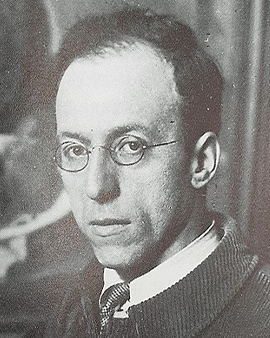Bernard Meninsky, a renowned artist, saw the light of day in Konotop, now part of Ukraine, in a family of Yiddish-speaking Ukrainian Jews. His father was a tailor and family life was characterized by hard work and simple circumstances. His original surname was probably "Menushkin." As a young child, Meninsky moved with his family to Liverpool, where he showed a remarkable talent for art at a young age. Despite leaving school early at the age of eleven, Meninsky was able to demonstrate his artistic skills by selling a drawing to a local comic book postcard dealer. He worked as an errand boy during the day, but spent his nights in free art classes. This dedication enabled him to gain a place at the prestigious Liverpool School of Art, where he studied from 1906 to 1911, funded by a series of scholarships. In the summers of 1909 and 1910 he took courses at the Royal College of Art in London, and in 1911 was awarded a scholarship to study for three months at the Académie Julian in Paris.
In 1912, his path led him to the Slade School of Fine Art in London, supported by the Liverpool Jewish community and the Jewish Educational Aid Society (JEAS). Here he crossed paths with artists such as David Bomberg, Isaac Rosenberg, Jacob Kramer and William Roberts, who became his contemporaries and in some cases lifelong friends. An important contact Meninsky made at this time was Walter Richard Sickert, who hosted Slade students and graduates in his Fitzroy Street studio. While at the Slade, Meninsky experienced the controversy surrounding Roger Fry's second Post-Impressionist exhibition at the Grafton Galleries in London, which was considered scandalous by the public for its modernism. While some of his fellow students explored their own form of "English Cubism," Meninsky's work remained less radical, though at the same time he was "completely overwhelmed by the greatness of Cézanne."
After graduating from the Slade in 1913, Meninsky worked for Edward Gordon Craig at his theater school in Florence. His experience with Craig was not fulfilling, however, and he returned to London where he began teaching nude drawing at the Central School of Arts and Crafts. Meninsky found a deep passion in teaching, and the connection to the Central School remained meaningful to him throughout his life. Each art print reflects Meninsky's deep passion for art and his impressive ability to capture emotion and ideas on canvas.
×





.jpg)
.jpg)
.jpg)
.jpg)
_-_(MeisterDrucke-1407816).jpg)
_-_(MeisterDrucke-1407816).jpg)
_-_(MeisterDrucke-1403254).jpg)
_-_(MeisterDrucke-1403254).jpg)
_-_(MeisterDrucke-1406676).jpg)
_-_(MeisterDrucke-1406676).jpg)
_-_(MeisterDrucke-1413213).jpg)
_-_(MeisterDrucke-1413213).jpg)
_-_(MeisterDrucke-1401512).jpg)
_-_(MeisterDrucke-1401512).jpg)
_-_(MeisterDrucke-1407817).jpg)
_-_(MeisterDrucke-1407817).jpg)
_-_(MeisterDrucke-1413200).jpg)
_-_(MeisterDrucke-1413200).jpg)
.jpg)
.jpg)
.jpg)
.jpg)
.jpg)
.jpg)
.jpg)
.jpg)
.jpg)
.jpg)
.jpg)
.jpg)
_-_(MeisterDrucke-1408725).jpg)
_-_(MeisterDrucke-1408725).jpg)
_-_(MeisterDrucke-1413199).jpg)
_-_(MeisterDrucke-1413199).jpg)
_-_(MeisterDrucke-1410253).jpg)
_-_(MeisterDrucke-1410253).jpg)
_-_(MeisterDrucke-1410284).jpg)
_-_(MeisterDrucke-1410284).jpg)
.jpg)
.jpg)
.jpg)
.jpg)
.jpg)
.jpg)
_-_(MeisterDrucke-1408834).jpg)
_-_(MeisterDrucke-1408834).jpg)
_-_(MeisterDrucke-1400327).jpg)
_-_(MeisterDrucke-1400327).jpg)
_-_(MeisterDrucke-1408952).jpg)
_-_(MeisterDrucke-1408952).jpg)
_-_(MeisterDrucke-1408954).jpg)
_-_(MeisterDrucke-1408954).jpg)
.jpg)
.jpg)
_-_(MeisterDrucke-1403176).jpg)
_-_(MeisterDrucke-1403176).jpg)
.jpg)
.jpg)
.jpg)
.jpg)
.jpg)
.jpg)
.jpg)
.jpg)
_-_(MeisterDrucke-1413613).jpg)
_-_(MeisterDrucke-1413613).jpg)
.jpg)
.jpg)
.jpg)
.jpg)
.jpg)
.jpg)
.jpg)
.jpg)




